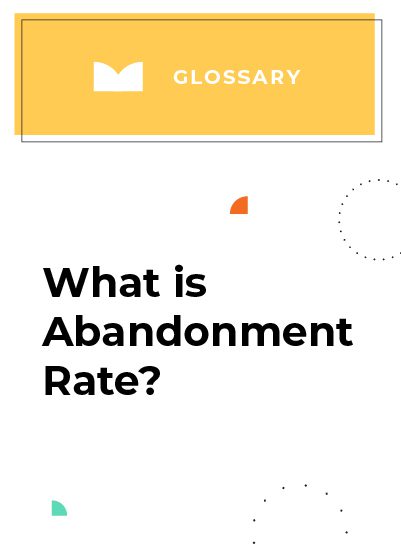
Abandonment Rate
What are Cart Abandonment Rates?
Abandonment rates are the rates at which users are leaving your website and abandoning their virtual shopping carts. This statistic shows the amount of users who were initially interested in your products compared to those who actually made a purchase.
Calculating Your Cart Abandonment Rate
To calculate your cart abandonment rate, consider the following formula:
Completed Transactions/ Shopping Carts with at least one item x 100 = Cart Abandonment Rate
Abandonment Rate Statistics
Shopping cart abandonment rates continue to rise. According to a report from Business Insider, $4.6 trillion worth of merchandise was left in abandoned carts in 2016, up from $4.2 trillion in 2013. This decline is a result of the emergence of more eCommerce sites and more advertising, creating more competition.
Additionally, as screens become smaller, this problem continues to grow. Consider the following statistics:
- Desktop: 73% abandonment rate
- Tablet: 81% abandonment rate
- Mobile: 86% abandonment rate
Although these numbers sound intimidating, these declining rates show an opportunity for businesses to further optimize the customer journey and connect with consumers across devices. For companies who are willing to face this challenge head-on, they will be rewarded with additional customer loyalty and a growing bottom line.
Reasons for Shopping Cart Abandonment
Good conversions rates suggest a good user experience. Unfortunately, the opposite also holds true. Bad user experiences lead to bad conversion rates and less than optimal abandonment rates. The first step to improving these rates is to understand the customer experience. Are they getting distracted or is there something wrong with the UI? To figure this out, consider these common causes:
Unexpected Costs
Does your site advertise a sale or promotion and then charge users with hefty fees for delivery or processing? Although consumers expect shipping fees, if they find the fees unreasonable they will abandon their cart. Hefty fees also cause a sense of unease in the customer, making it less likely that they will return.
No Guest Checkout Options
Forcing users to create an account adds another step in the checkout process and could get them to reconsider their purchase. Additionally, signing up for an account requires a certain level of trust from the end-users. For users who are more reluctant to give out their information online, they will be more hesitant, hindering them from making a purchase.
Lengthy Checkout Process
Amazon understood that if it wanted to own the market, they needed to make the user experience as seamless as possible. In 1999, they patented 1-Click, which allowed users to make purchases with a click of a mouse. This patent (which expired in 2017) was one key in helping them rise to the eCommerce leaders they are today.
Having a shorter checkout process is more important in today’s world than ever with the smaller screens on mobile devices. Long forms and a failure to personalize the experience, especially for frequent customers, can have a heavy impact on sales.
Delivery Time
If a client has to wait too long to receive a package, they may decide they can do without a product. In today’s age, customers expect fast delivery options, especially if they are in a hurry. Consider the holiday season. In a survey, more than 50% of shoppers admit to doing their holiday shopping last minute. If your company cannot accommodate last-minute shoppers, they will take their business elsewhere.
Improving Your Abandonment Rate
Offer the Right Product Recommendations
There are countless upsell opportunities to upsell customers or prospects based on their browsing history, past purchases, or current shopping cart. And these upsell opportunities have a long term effect. According to our EQ2 2018 study, return sessions for recommended products convert about 45% more often than return sessions for customers who left non-recommended items in their cart. Additionally, return sessions for recommended products also have a 38% higher AOV than return sessions for non-recommended products.
Offer Exceptional Customer Service
If customers are struggling with the checkout process, is there an easy way for them to get in touch with a sales representative? Including a live chat feature on your site can help address customer questions in real-time. If customers have questions, you should also have a team ready to answer them via email or phone. Be sure to also monitor your Yelp pages and social media platforms to address customer concerns as they come in. Earning a reputation for being customer-centric will help you earn brand loyalty and trust, which are essential components of improving your cart abandonment rate.
Improve Delivery Times
Today’s clients are used to fast delivery service at reasonable pricing. Providing options to address all customer needs (speed of delivery, price of delivery), consider giving potential clients options for receiving their package. For example: a fee, they can get it the next day. To qualify for free shipping, they could choose the standard shipping option.
Improve the Mobile Experience
79% of mobile users have made a purchase on their mobile phone in the last 6 months. Sites need to not only be optimized for mobile, but designed with mobile in mind. Having drop-down lists (for items such as two-letter state initials) or lengthy forms can be a hindrance to having mobile users complete a form.
Make It Easy to Return Items
Clothing stores in particular struggle with cart abandonment rates. In brick-and-mortar stores, it feels easier to return clothing. Additionally, customers can try on clothing to make sure the fit is right before making a purchase.
If you’re struggling with cart abandonment rates, consider minimizing the risk of purchase for a consumer. Is there a way to make the return process easier? To encourage customers to try on a size, make it easy for them to exchange items.
Offer Customer Reviews
Customer reviews make it easy for potential shoppers to see how others who actually purchased the product enjoyed the item. This endorsement by a real customer is powerful is ultimately convincing any shoppers with doubts to convert.
